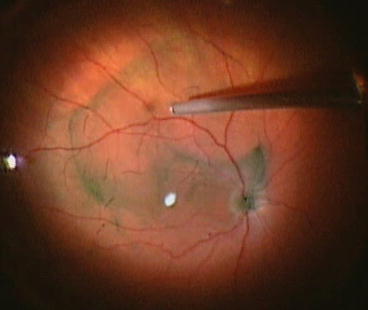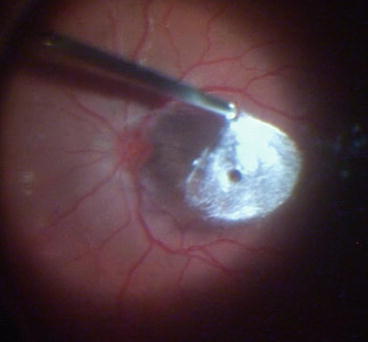(1)
St. Johns, FL, USA
(2)
Helen Keller Foundation for Research and Education, International Society of Ocular Trauma, Birmingham, AL, USA
(3)
Consultant and Vitreoretinal Surgeon, Milos Eye Hospital, Belgrade, Serbia
(4)
Consultant and Vitreoretinal Surgeon, Zagórskiego Eye Hospital, Cracow, Poland
It is a strange paradox that VR surgeons, whose goal is to restore vision, are often forced to work with tissues1 that are very difficult or impossible to visualize. The use of dyes – or markers2 – makes numerous tasks easier for the surgeon and safer for the patient (see also Sect. 27.3.3).
34.1 Posterior Vitreous Cortex
Autologous blood 3 and ICG are able to faintly stain the vitreous, but the former is not an easy material to prepare and use for this purpose, while the latter does not result in a consistent marking (see Fig. 34.1).


Fig. 34.1
ICG-staining of the posterior cortical vitreous. The green dye created a faint marking of the vitreous that is still present on the posterior retina. In eyes with poor contrast and lack of the normal pigmentation in the posterior pole this may be the only option to show the presence of the posterior cortical vitreous (see Sect. 56.2)
The material of choice is TA. Either use a preservative-free version4 or filter it if you want to leave it behind; if used for diagnostic purposes only, there is no need for filtration.
Following the creation of a small vitreous-free pocket in front of the posterior pole (see Sect. 27.4), inject a miniscule amount of TA over the posterior pole.
Aspirate all excess (free-floating, non-sticking) crystals.
Pearl
If the crystals adhere to the surface, this is evidence that there is PVD. If there is no crystal sticking, it is still possible that PVD has not occurred; the inner surface of the vitreous is simply too smooth for the crystal to adhere to it (false-negative result; see Sect. 27.4).

Fig. 34.2
TA marking the nondetached posterior hyaloid. The crystals clearly signal the presence of vitreous on the posterior retina. The PVD is created by aspiration using the (20 g) probe. A tiny hole in the middle shows that the posterior cortical vitreous was absent over the fovea
34.2 EMP
The membrane can be stained directly (using trypan blue5) or highlighted via “negative staining” against a stained background (see Fig. 32.9b). Trypan blue stains both the EMP6 and the ILM, but the ILM stains much more weakly. A dye combination7 is able to stain both membranes well.
Stay updated, free articles. Join our Telegram channel

Full access? Get Clinical Tree


